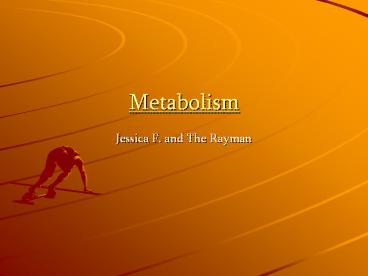Metabolism - PowerPoint PPT Presentation
1 / 10
Title:
Metabolism
Description:
Anabolism is the process by which a cell combines smaller ... Calcitonin. Lowers calcium levels in the blood. Parathyroid glands. Parathyroid hormone ( PTH) ... – PowerPoint PPT presentation
Number of Views:22
Avg rating:3.0/5.0
Title: Metabolism
1
Metabolism
- Jessica F. and The Rayman
2
Basic Terms
- Anabolism
- Anabolism is the process by which a cell
combines smaller molecules into larger, more
complex molecules. Such as carbohydrates, lipids
and proteins. By doing this, a cell can store
energy in the molecules and use it later. - Anabolism is most commonly used build up organs
and tissues in an organism. - Catabolism
- Catabolism is the opposite of anabolism. It
refers to the process by which large polymeric
molecules that were formed by anabolism are
broken down into their less complex forms (such
as amino acids and monosaccharides
respectively). - The main way that anabolic and catabolic
reactions take place is hydrolysis and
dehydration reactions.
3
Hydrolysis and DehydrationReactions
To the right is an example of a
dehydration reaction. It shows water being taken
out of sucrose to build a larger molecule out of
two smaller ones. This is an anabolic process and
stores energy in the large molecule when it is
formed. Also, it shows a hydrolysis
reaction. It is just the opposite of a
dehydration reaction. By adding water to the
large polysaccharide, you end up splitting the
molecule in two. This produces energy.
4
Just what and where is Metabolism?
- Metabolism refers to the total sum of all the
anabolic and catabolic processes that happen
within a cell or organism. The anabolic and
catabolic process are performed through a series
of complex chemical reactions known as metabolic
pathways. The metabolic pathways are catalyzed by
various enzymes. There are a few different types
of these enzymes, and they all do different
things
Classic catabolic hormones Cortisol
Glucagon Adrenalin(e)
and other catechizations Cytokines
Classic anabolic hormones Growth hormone IGF1
and other insulin-like growth factors Insulin
Testosterone Oestrogen
Due to the fact that it is
counterproductive to have anabolic and catabolic
processes occurring in cells simultaneously,
there are many signals that switch on anabolic
processes while switching off catabolic processes
and vice versa.
5
6
Lots of Energy
- Energy is the ability to do work
- Potential energy is stored in the chemical bonds
of molecules. Carbon-carbon and carbon-hydrogen
bonds are relatively rich in energy. This energy
is released when the chemical bond is broken. The
released energy will be metabolized in a form
that can be easily used by the cell. - Kinetic energy is the energy an object has
because it is in motion like moving, crying or
eating. - Work is the transfer of energy from one place to
another. - Bond energy is the minimum energy required to
break one mol of bonds between two species of
atoms.
7
Lots and lots of Energy
- Adenosine triphospahte (ATP) is the key source of
free energy (energy that can do useful work) in
living cells. - When the cell requires free energy to drive an
endothermic reaction, an enzyme called ATPase
catalyzes the hydrolysis of the terminal
phosphate of an ATP molecule, resulting in a
molecule of ADP, a molecule of inorganic
phosphate and the release of 31KJ/mol of FREE
ENERGY.
ATP H2O ? ADP Pi ?G -31
KJ/mol
8
Do some MATH now
Type of activity Energy Factor (KJ/kg/h)
Sleeping 4.1
Cooking 10.5
Bowling 13.6
Climbing stairs 37.5
Competitive cross -country skiing 73.6
Sleeping for 8 hours Energy factor (KJ/kg/h) X
body mass (kg) X time (h) 4.1 (KJ/kg/h) X 75 kg X
8h 2460 KJ (to convert pounds to kg your
weight in pounds / 2.2)
Energy requirement Teenage girl 9500
KJ/day Teenage boy 12000 KJ/day
9
Fun Facts
- People getting gt 9200 KJ/ day are considered
starving. - Larger people have greater cells and greater
energy needs. - The more active a person is the greater their
energy requirements are. - Different people, even if they have same body
mass, have different rate which metabolism occurs
in body. - A chemical messenger produced in the thyroid
gland regulates the rate at which food energy is
converted into other forms of energy by the cells
of the body. - If the release of the chemical messenger from the
thyroid gland increases metabolism increases. - A person with a high metabolic rate converts a
larger portion of the food energy into heat, less
food energy is converted into fat and the person
remains relatively thinner.
10
Energy































